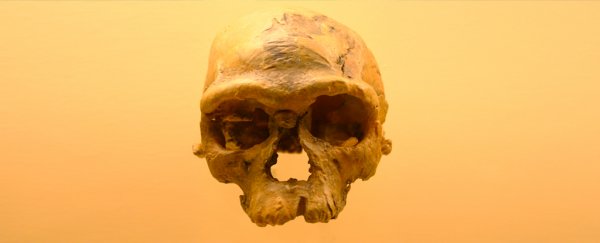The t-shirt representation of human evolution as a sequence of hunched primates standing tall is a popular cliché.
Of course, deep down we know it has to be more complicated. New research argues we seriously don't know the half of it – the journey of humanity is far more diverse than we ever imagined.
Scientists representing a variety of disciplines and institutions have put together an argument that suggests we really need to change how we think of our origins, and see the bigger picture of modern Homo sapiens as a patchwork of populations in a hypothesis called African multiregionalism.
Eleanor Scerri is an archaeologist from the University of Oxford and the Max Planck Institute for the Science of Human History. Her work contributes to a picture of a fractured family tree of early modern humans that doesn't so much as branch, as splinter and braid over time.
"In bringing together people from such diverse fields, we've arrived at a place where we can begin to address some key questions about our shared ancestry and even emerge with new questions we haven't known to ask before," says Scerri.
Hominins have been journeying out of the African continent for literally millions of years, leaving bones and simple tools as signs of their progress.
But the 7.6 billion Homo sapiens living around the planet today can all trace their genes back to a population that branched away from a closely related species not that long ago - in geological terms.
The discovery of new fossils coupled with improved analytical tools has meant a near-constant revision of our understanding of the nature of that branching, with the current time of departure estimated to be some 300,000 years ago.
But those same discoveries have also made us wonder just what our parent population might have looked like.
Bone fragments found near Marrakesh in Morocco, for example, have enough features in common with 260,000 year old skull pieces found in South Africa to prompt questions on how they might be connected.
Traditionally, we've imagined a single birthplace somewhere in sub-Saharan Africa, perhaps pinching away from a group like Homo heidelbergensis. But the fossils, genes, and archaeology tell a very different story.
"In the fossil record, we see a mosaic-like, continental-wide trend toward the modern human form," says Scerri.
"The fact that these features appear at different places at different times tells us that these populations were not well connected."
This idea of a local "Cradle of Humankind" needs to be thrown out according to researchers, in favour of a multiregionalism explanation.
Their hypothesis describes a picture of diverse populations of human ancestors scattered across the continent exploiting an array of ecosystems, each far more anatomically distinct than today's populations.
Instead of strictly isolated hunter gatherers eking out a meagre existence, it looks like there was still occasional but significant cross-pollination between these separate communities.
"This fits with a subdivided population model in which genetic exchanges are neither random nor frequent," says Scerri.
What makes us unique as modern humans is a patchwork of traits that evolved in numerous regions at different points in time.
"To understand our genetic and cultural diversity or where being human comes from – our behavioural flexibility and biological plasticity – we have to look at an ancient history of population subdivision and diverse ecologies across Africa," says Scerri.
Revising our heritage opens the way to looking at fossil records in a new light, seeing the appearance of new features as a reflection of lost populations rather than stages in a single lineage.
It's a story we're already rewriting as we learn more about our relationships with other human populations, such as Neanderthal and Denisovans.
Today's human population is relatively dull and homogeneous by comparison. We're slowly learning just how complex our history is, and how interwoven our global community happened to be.
"We are an evolving lineage with deep African roots," says Scerri.
"So to understand this history, we must re-examine evidence from diverse sources without a priori conceptions."
This research was published in Trends in Ecology and Evolution.
